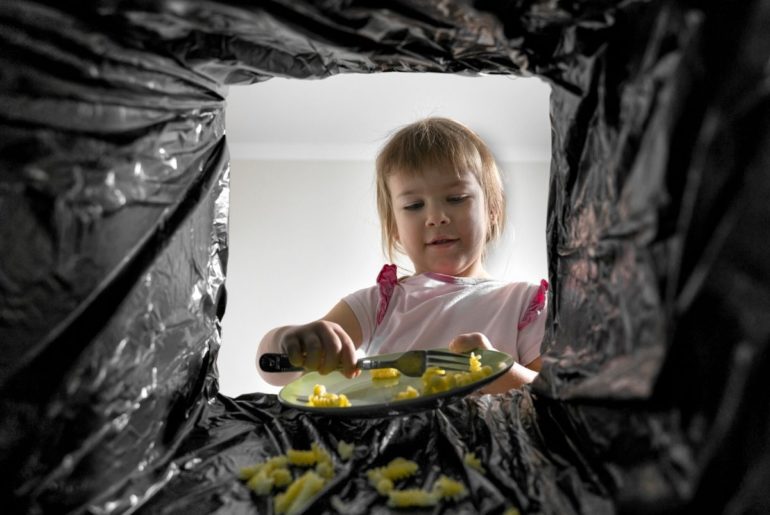All those scraps of food left behind on dinner plates and fruit that spoiled before it was eaten may not seem like a deal on its own, but add it up. You’d be surprised how much food Americans waste—a whopping 30 to 40 percent of the overall food supply, to be exact!
Tossing food doesn’t just waste money, it has a negative impact on the environment, too. Making, moving, and storing food requires tons of energy, which emits greenhouse gases that contribute to climate change. In fact, food waste is the largest component of solid waste reaching landfills, according to the Environmental Protection Agency (EPA).
But those aren’t the only reasons to teach children to value food. The United Nations estimates that 1 in 9 people don’t have access to enough food to lead a healthy life—yet, nearly one-third of the food that is produced in the world is wasted.
Kids who learn to value food at a young age are more likely to grow up to have good eating and waste habits, maximizing the positive impact and minimizing the bad. Luckily, there are things your family can do at home to help minimize food waste.
Have a food waste contest.
Try setting a family goal, such as reducing your waste for a month by about 25 percent, and work together to make it happen. Sustainable America, a nonprofit organization dedicated to making the nation’s food and fuel systems more efficient, has a free food waste challenge that helps you figure out how much food your household wastes, then provides tips and tricks to help your family make small changes to the way you shop, store, and prep food. If your family reaches its goal, treat yourselves to a fun reward, such as a daily picnic or a day trip.
Freeze fruits and veggies for smoothies, baked goods, or even popsicles.
From banana and zucchini breads to fruit and veggie smoothies and even icy pops, there are so many ways to use leftover fruits and veggies. Have kids help you make a list of yummy ways to use the leftovers, and place it in a high-traffic area where everyone can see. Any time you have extras, let the kids decide how to enjoy them the next day.
Learn the right portion sizes.
The truth is, most of us place way more on our plates—and our children’s plates—than necessary, which leads to more waste and often, more food battles between parents and kids. If you want your child to “clean their plate” to minimize waste, make sure you’re serving the right amount of food. The American Academy of Pediatrics has a handy chart with examples of portion sizes for children ages 1 to 10. Smaller portion sizes are especially important when you’re introducing new foods and you’re not sure how your child is going to react.
It’s also a good idea to get kids to recognize proper portion sizes themselves. One fun way to do that is by teaching shortcuts, like these:
- 1 fist = 1 cup of pasta, rice, cereal, vegetables, and fruit
- 1 portion of meat = the size of your palm
Make sure your kiddos are hungry at mealtime.
Once you’re serving the right portions, the best way to ensure they’re ready to dig in and leave behind minimal waste during meals is to get a handle on snacks. Try keeping the high-calorie and high-fat snacks like chips and cookies out of reach of little ones, or avoid buying them altogether. For everyday snacking, stock up on snack foods that pack enough fiber to keep everyone satisfied until the next meal. Fruits and veggies will generally do the trick, especially apples, avocados, and mangos, but high-fiber cereals, nuts, and popcorn are also good choices.
Start using a compost bin.
Composting is a great way to reuse food waste by turning it into a nutrient-rich plant fertilizer, plus it’s a great science lesson for children (hello decomposition). Many cities have food waste programs that provide each home with a bin, similar to recycling programs But you can also make your own compost bin with a soda bottle and a few other basic supplies you likely already have around the house (for younger kids, we also love this simple backyard compost bin). The DIY versions provide an opportunity to teach kids why composting is important. Plus the more engaged and involved they are in the process, the more likely they’ll make it a habit of reducing and reusing their waste.
Check your fridge and pantry before you shop for groceries.
Sometimes, waste occurs because we never get around to eating the food we buy, prompting it to spoil or pass its expiration date. One easy way to avoid buying more than you’re likely to eat is to check what you already have in the fridge, pantry, and cupboards against your shopping list before you buy anything else. This is a great job for little ones who love to compare and cross items from lists. Meal planning also helps, because you know exactly how much of each food you’ll need—and which random impulse buys you won’t need. The more your family can avoid buying “extra” food, the less likely the food will go waste.
Reducing food waste is good for society, the environment, and your family budget. With a few simple changes to your routine, you can teach your kids important lessons about conservation while also doing your part!







